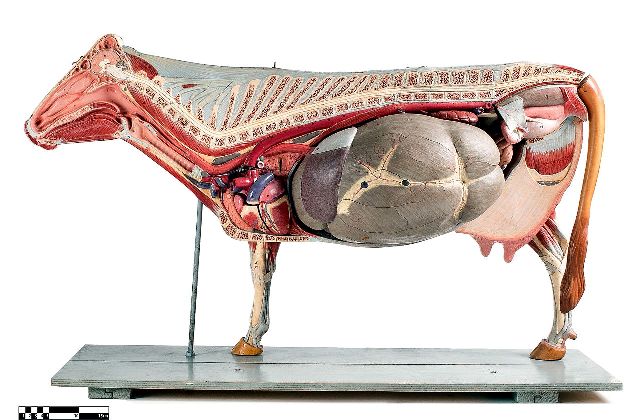Livestock and Climate Change
Livestock and Climate Change
Livestock and Climate Change: What if key actors in climate change are...cows, pigs, and chickens?
Worldwatch / State of the World (2009)
The environmental impact of the lifecycle and supply chain of animals raised for food has been vastly underestimated, and in fact accounts for at least half of all human-caused greenhouse gases (GHGs), according to Robert Goodland and Jeff Anhang, co-authors of "Livestock and Climate Change".
A widely cited 2006 report by the United Nations Food and Agriculture Organization, Livestock's Long Shadow, estimates that 18 percent of annual worldwide GHG emissions are attributable to cattle, buffalo, sheep, goats, camels, pigs, and poultry. But recent analysis by Goodland and Anhang finds that livestock and their byproducts actually account for at least 32.6 billion tons of carbon dioxide per year, or 51 percent of annual worldwide GHG emissions. (note: livestock greenhouse gas statistics vary widely among current studies)
Whenever the causes of climate change are discussed, fossil fuels top the list. Oil, natural gas, and especially coal are indeed major sources of human-caused emissions of carbon dioxide (CO2) and other green house gases (GHGs). But we believe that the life cycle and supply chain of domesticated animals raised for food have been vastly under estimated as a source of GHGs, and in fact account for at least half of all human-caused GHGs. If this arg ument is right, it implies that replacing live-stock products with better alternatives would be the best strategy for reversing climate change. In fact, this approach would have far more rapid effects on GHG emissions and their atmospheric concentrations — and thus on the rate the climate is warming than actions to replace fossil fuels with renew able energy.
················
Read More:
Energy, Environment and Resources
December 2014
Livestock – Climate Change’s Forgotten Sector Global Public Opinion on Meat and Dairy Consumption
Consumption of meat and dairy produce is a major driver of climate change.
Greenhouse gas emissions from the livestock sector are estimated to account for 14.5 per cent of the global total, more than direct emissions from the transport sector.
Even with ambitious supply-side action to reduce the emissions intensity of livestock production, rising global demand for meat and dairy produce means emissions will continue to rise. Shifting global demand for meat and dairy produce is central to achieving climate goals.
Recent analyses have shown that it is unlikely global temperature rises can be kept below two degrees Celsius without a shift in global meat and dairy consumption.
Reducing demand for animal products could also significantly reduce mitigation costs in non-agricultural sectors by increasing their available carbon budget. However, there is a striking paucity of efforts to reduce consumption of meat and dairy products.
A number of factors, not least fear of backlash, have made governments and environmental groups reluctant to pursue policies or campaigns to shift consumer behaviour.
The lack of attention afforded to the issue among policy-makers and opinion-formers contributes to a lack of research on how best to reduce meat and dairy consumption.
As a first step in addressing this lack of research, Ipsos MORI was commissioned by Chatham House to undertake the first multi-country, multilingual online survey specifically to explore public attitudes on the relationship between meat/dairy consumption and climate change.
○
U.S. Greenhouse Gas Inventory Report: 1990-2014
Greenhouse Gas Inventory Data Explorer
EPA develops an annual report called the Inventory of U.S. Greenhouse Gas Emissions and Sinks (Inventory). This report tracks total annual U.S. emissions and removals by source, economic sector, and greenhouse gas going back to 1990. EPA uses national energy data, data on national agricultural activities, and other national statistics to provide a comprehensive accounting of total greenhouse gas emissions for all man-made sources in the United States. EPA also collects greenhouse gas emissions data from individual facilities and suppliers of certain fossil fuels and industrial gases through the Greenhouse Gas Reporting Program.
https://www.epa.gov/ghgemissions/us-greenhouse-gas-inventory-report-1990-2014
https://www.epa.gov/sites/production/files/2016-06/documents/us_ghg_inv_fastfacts2016.pdf
○
Going vegetarian halves CO2 emissions from your food
○
Meat Eaters Guide to Climate Change
○
Dietary greenhouse gas emissions of meat-eaters, fish-eaters, vegetarians and vegans
http://link.springer.com/article/10.1007/s10584-014-1169-1
○
Land, irrigation water, greenhouse gas, and reactive nitrogen burdens of meat, eggs, and dairy production in the United States
http://www.pnas.org/content/111/33/11996.abstract
○
Better livestock diets to combat climate change and improve food security
http://www.iiasa.ac.at/web/home/about/news/20140225-PNAS.html
○
Vegetarian or omnivore: The environmental implications of diet
